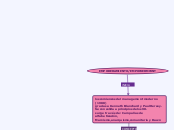Estrategias que promueven la compresión mediante la organización de la información.
To name your story, you have to think about the overall message and what you want your audience to understand from the story. Also, make it relevant and easy to remember.
Analogía
Comprender contenido complejo.
Se eligen los elementos que se desean relacionar
Es una estrategia de razonamiento que permite relacionar elementos o situaciones.
Correlación
Identificar conceptos o ideas claves.
La principal característica de este diagrama es la jerarquia de los conceptos.
Es un diagrama semejante a un modelo atómico donde se relacionan entre si los conceptos.
Técnica de heurística uve de Gowin
Esta integrada
Teória
preguntas centrales
proposito
punto de enfoque
parente central
Es una estrategia que sirve para adquirir conocimientos sobre el propio conocimiento y sobre como se construye o se utiliza.
Matriz de inducción
The ending of a story is essential. We all know that if the ending is weak, what happened before loses its importance. So make it unpredictable, but fair. A resolved ending answers all the questions and ties up any loose threads from the plot.
Legar a determinar detalles que a simple vista no se pueden determinar.
This is the closure section of the story.
See examples of possible outcomes below:
- all problems have been solved
- it's clear how each one of your characters ends up
- your main character is transformed by the challenge
Se organizan los elementos en grupos iniciales.
Se identifican los elementos que se desean clasificar y se hace un listado.
Try answering these questions to come up with a closure:
- Have all the problems been solved?
- Is there a clear picture of what happens with each character in the story?
- Has the challenge transformed your main character?
- How do the characters feel in the end?
This is the moment when the main character surpasses the last obstacle and finally faces their greatest challenge.
The climax usually follows one of these patterns:
- realization
- resolution
- choice
Type in your answer.
Es una estrategia que permite hacer la distinciones de de detalladas de las características de algún tipo de información.
Cuadro comparativo
The middle of the story is where you add layers of complications that will lead to the end. Reveal more about the character's journey. Did their personality go through changes? How did they overcome the challenges? And as you build up the story’s central conflict, make it more personal to that character. Also, from the middle act, you have to lead into the final act.
Ayuda a organizar el pensamiento.
Facilita el procesamiento de datos.
Permite desarrollar la habilidad de comparar.
¿Como se realiza?
Se identifican y escriben las características.
Se marcan los parámetros a comparar
Se identifican los elementos que se desea comparar.
Each story has a main character and that character usually needs to solve a problem or challenge. The character's challenge is the one that creates tension throughout the story.
El cuadro comparativo es un estrategia que permite identificar las semejanzas y diferencias de dos o mas objetos o hechos.
In most stories, there are 3 challenges. The number 3 is a mystical number symbolizing completeness. Try to come up with interesting challenges with which your character needs to struggle.
See a few examples below:
- turns into a werewolf at night
- is sent back in time
Cuadro sinóptico
In the beginning of the story (or the exposition), you will need to introduce the setting and characters. You might also want to introduce the main conflict. This part of the story is important because it gives the reader necessary background information and maybe even a first insight into a character’s personality.
¿Para que se utiliza?
Facilitar la comprensión de un tema.
Organizar el pensamiento.
Desarrollarla habilidad para clasificar y establecer jerarquías.
Establecer relaciones entre conceptos.
¿Como se realizan?
The setting (time & place) of a story can change throughout the plot.
Se utilizan llaves para señalar las relaciones.
Sensory details include sight, sound, touch, smell, and taste. These details are important because they create depth in your setting.
See a few examples below:
- the smell of fresh bread
- the scent of freshly cut grass
- rain falling onto the windshield etc.
Se categorizan los conceptos estableciendo relaciones de jerarquía.
The weather is an important element in your story because it can highly influence the ambiance and the mood of the characters.
Se derivan los conceptos secundarios o subordinados.
The time of the story can also change. It can describe the event of a single day or can include an entire year's plot. Anyway, don't forget to mention it.
Se identifican los conceptos generales o inclusivos.
Your story can take place wherever your imagination will take you to.
For example: in an elevator, in an enchanted forest, etc. Don't forget to give details of the environment each time the setting changes, otherwise, the story can be confusing. Also, mention the seasons as each of them has unique weather and events.
¿Que es?
Characters are essential to a good story. Usually, the protagonist(s) is/are the most affected by the plot. Introduce a character by focusing on their actions, interests, and occupation, as the physical appearance doesn't make a difference in most cases.
Es un organizador gráfico muy utilizado, ya que permite organizar o clasificar información.
Type in the name of your character.










